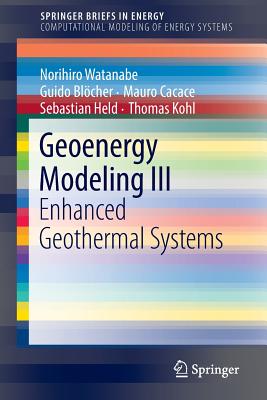
Geoenergy Modeling III: Enhanced Geothermal Systems
Current price:
$57.74
Publication Date: November 21st, 2016
Publisher:
Springer
ISBN:
9783319465791
Pages:
104
Usually received by store in 2-5 days.
Description
This book focuses on numerical modeling of deep hydrothermal and petrothermal systems in fractured georeservoirs for utilization in Geothermal Energy applications. The authors explain the particular challenges and approaches to modeling heat transport and high-throughput flow in multiply fractured porous rock formations. In order to help readers gain a system-level understanding of the necessary analysis, the authors include detailed examples of growing complexity as the techniques explained in the text are introduced. The coverage culminates with the fully-coupled analysis of real deep geothermal test-sites located in Germany and France.
Other Books in Series
The Unity of Science and Economics: A New Foundation of Economic Theory
Hardcover
Basic Tutorial on Simulation of Microgrids Control Using Matlab(r) & Simulink(r) Software (Springerbriefs in Energy)
Paperback
Geoenergy Modeling II: Shallow Geothermal Systems
Paperback
Models of Thermochemical Heat Storage
Paperback
Failing States, Collapsing Systems: Biophysical Triggers of Political Violence
Paperback
The Economics of Oil: A Primer Including Geology, Energy, Economics, Politics
Paperback
Computational Geotechnics: Storage of Energy Carriers
Paperback
The First Half of the Age of Oil: An Exploration of the Work of Colin Campbell and Jean Laherrère
Paperback
Preparing for Peak Oil in South Africa: An Integrated Case Study
Paperback
The Chinese Oil Industry: History and Future
Paperback
Energy Optimization and Prediction in Office Buildings: A Case Study of Office Building Design in Chile (Springerbriefs in Energy)
Paperback
Nonlinear Modeling of Solar Radiation and Wind Speed Time Series (Springerbriefs in Energy)
Paperback
Renewable Synthetic Fuels and Chemicals from Carbon Dioxide: Fundamentals, Catalysis, Design Considerations and Technological Challenges (Springerbriefs in Energy)
Paperback
The Future of Gas Networks: The Role of Gas Networks in a Low Carbon Energy System (Springerbriefs in Energy)
Paperback
Impact of Occupants' Behaviour on Zero-Energy Buildings (Springerbriefs in Energy)
Paperback
Rethinking Economic Growth Theory from a Biophysical Perspective
Paperback
Energy and the Financial System: What Every Economist, Financial Analyst, and Investor Needs to Know
Paperback
Tracking Solar Concentrators: A Low Budget Solution (Springerbriefs in Energy)
Paperback
Minimization of Climatic Vulnerabilities on Mini-Hydro Power Plants: Fuzzy Ahp, Fuzzy Anp Techniques and Neuro-Genetic Model Approach (Springerbriefs in Energy)
Paperback





